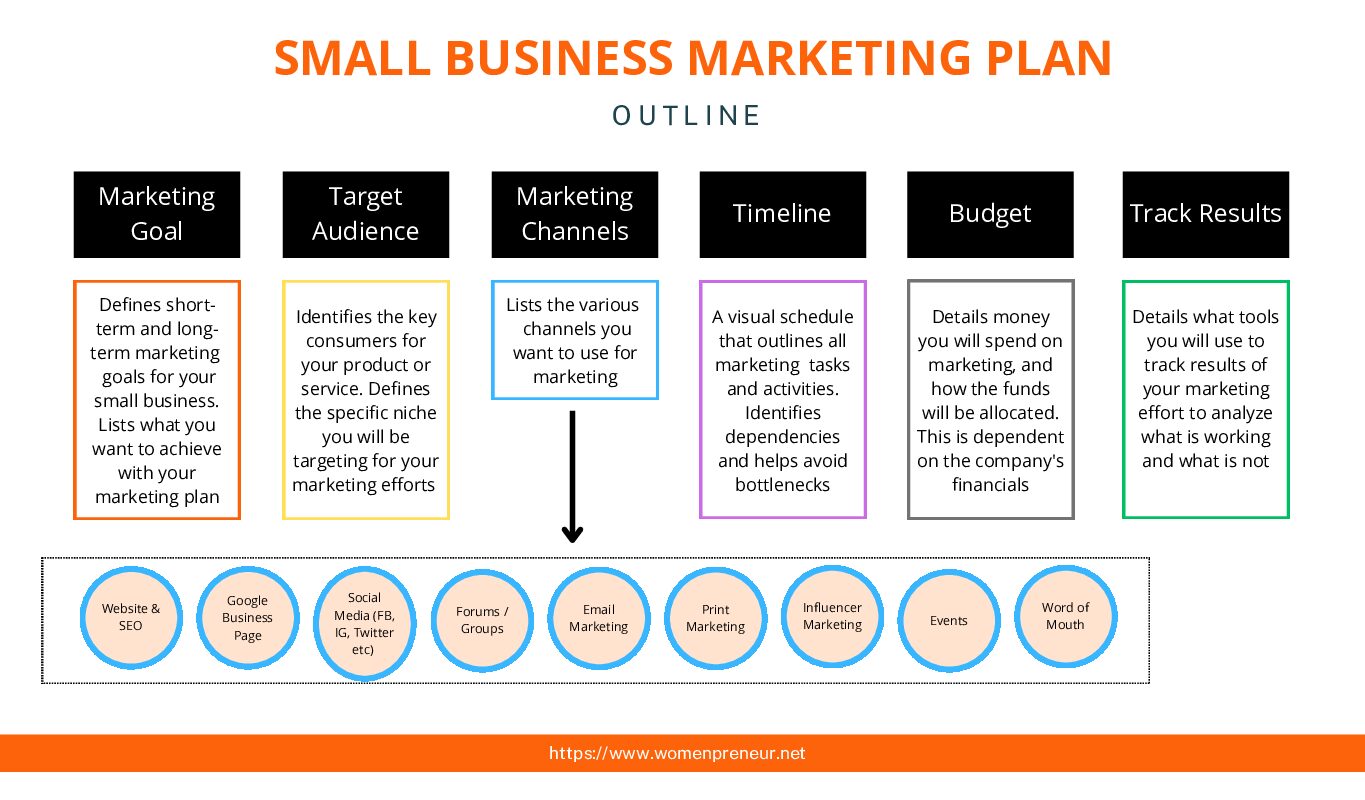run your business
6 Steps for creating an outstanding Marketing Plan for your small business
If there is one thing women entrepreneurs can start even before officially launching their small business, it is marketing for their small businesses. This is true for any business really – whether it is a small mom and pop store, a start up or even medium sized company. It is never too early to start marketing your idea and your business.
A big issue I have seen (and I am also guilty of this) is that many people don’t start marketing early enough as they worry about sharing their business idea with others thinking the idea will be stolen by someone else. Trust me that that shouldn’t be a worry because for starting and growing a business, execution is key and it is extremely hard to copy execution.
Every business owner should start their marketing efforts as early in the game as possible. Getting your message out there, understanding the pain points of your audience, researching your competition, defining and redefining your niche and getting clarity on your target audience is an evolving process and it takes time. The earlier you start, the better it is. The more you work at it, the better your marketing effort becomes.

Creating a marketing plan can seem daunting, but it is a worthwhile investment for any small business owner. By following the outline below, you can create a plan that will help you to achieve your marketing goals and grow your business.
What is a Marketing Plan?
When you start a business, there will be so many things to do and you will very quickly be overwhelmed by everything around you. Often times small business owners get caught up in the day-to-day operations and struggle to keep their head above water getting their business off the ground and running their business, they forget one of the most critical pieces to the success of the business which is marketing.
A marketing plan is a document that outlines your small business’s marketing goals, strategies, and techniques. It should be tailored to your specific business and target audience, and it should be updated regularly to reflect your changing goals and needs.
Why should you create a Marketing Plan?
Just like the saying goes “If you fail to plan, you are planning to fail”, planning your marketing efforts allows you to thoughtfully approach marketing as a whole for your business. There are several ways marketing can be done, and it is essential to understand the various channels and what best fits your business needs.
A marketing plan allows you to research, analyze and document your strategy for marketing. It is a valuable tool for businesses of all sizes. It can help you to:
A marketing plan allows you to research, analyze and document your strategy for marketing. It is a valuable tool for businesses of all sizes. It can help you to:

-
Plan your marketing: A marketing plan will allow you to be deliberate with your marketing rather than it being an after-thought
-
Increase brand awareness: It can help you to get your brand in front of more people. The more people that know of your business, the better it is
-
Generate leads: A good marketing plan will help you to generate leads, which are potential customers who are interested in your products or services. Your goal should be to have leads flowing in all the time
-
Close sales: Your ultimate goal with the marketing plan is to close sales and build a pipeline of customers
-
Grow your business: A well-executed marketing plan can help you to grow your business by increasing sales, expanding your customer base, and entering new markets
How to create a Marketing Plan:
There are several ways to put together a Marketing Plan. You can create one from scratch or you could make it simple for yourself and download our free Marketing Plan template.
Here are the main sections of a Marketing Plan:

Now let’s look at each of these sections in detail.
1. Marketing Goal
This defines the marketing goals for your small business, in the short-term and long-term. Think about what you want to achieve with your marketing plan? For example, a business owner who is in the inception stage of the business and does not products or services ready to offer yet may want to focus on building awareness with their audience while an established business might want to focus on bringing in new leads and closing sales.
2. Target Audience
This section talks about identifying who are the users and purchasers of your product or service and ways to get your product or service in front of these people. Note that in some cases the purchasers of the product could be different than the people who are actual users of your product. For example, let’s say your small business sells math guides for kindergartners. In this case, you need to keep the little kindergartners in mind while designing your product but when marketing the product, you would need to think of the parents and potentially teachers who would be the purchasers of your product.
Try to get as detailed as possible when defining your target audience. Understand what are their needs and wants? What are their pain points? Ultimately, when you start marketing, you want your efforts and funds to be focussed on a narrow niche rather than a broad set of people.

3. Marketing Channels
In the present times, there are so many different marketing channels and it is essential to choose the right marketing channels for your business and your target audience. One the main questions to ask yourself is which channels does your target audience frequent. That is where you would need to go as well.
I have listed the most efficient marketing channels below:
Website and SEO:
Your website is your main marketing vehicle. A good website which clearly illustrates your product or service offering, how it solves your customer’s pain points, the customer base you specialize in and an About page which talks why you do what you do is critical to the success of your business. Your website should be linked to your social media pages and should serve as the “central home” for all your marketing sites and assets.
You must ensure your website is optimized for Google search engine so it comes up when people search for keywords related to your product or service. Your goal should be to direct your audience to your website there by growing the traffic to the site. This helps with better ranking of your site on Google search results page.
SEO which stands for Search Engine Optimization involves strategies and tactics for optimizing your site and content for Google search engine. Check out our in-depth article on simple tips for SEO optimization of your small business site.
Google Business Page:
This could technically go under Social Media channels but I really like to list it as it’s own independent category. Setting up your Google My Business page is an essential part of your marketing plan. It is a free tool that helps you create a company profile that appears in Google searches. You can define information about your business, add pictures and publish posts regularly. This is also the page where clients and customers leave reviews. Google My Business page is crucial in improving the SEO for your site.

Social Media Marketing Channels:
Everyone is on social media these days, but it was not true for me when I started my business. I am an introvert and lacked presence on almost all social media sites. I pushed myself outside of my comfort zone and created my business accounts on the main Social Media sites relevant for my business such as Facebook, Instagram and Twitter.
Facebook
Instagram
Twitter
Pinterest
Linked In
You Tube
Tik Tok
There are so many different types of posts you can put on these sites but creating a plan around the content is a great idea. You could do informational posts about your product or service, posts showing your company culture and employees, posts addressing pain points your audience faces, posts illustrating the benefits of using your product or service and screen grabs of testimonials from clients. These are just some of the ideas and I have barely scratched the surface here.
The most important thing is to be consistent with your posts and this is where you decide up front how many times you will post content in a week and what will you post. For example, you could decide you will publish posts 2-3 times a week comprising of one informational post, one entertainment or fun post and one testimonial from a client.
Forums and Groups:
Forums is another excellent social media channel. Reddit, Quora, Facebook groups are some of the popular ones but pretty much every social media application now provides the ability to create and subscribe to groups. Becoming part of the forums where your target audience visit and participating in discussions there is a great idea to interact with your audience and allowing them to know you gradually.
There are no short cuts here. Social media marketing takes time and effort. And I cannot say this enough – Consistency is key.
Email Marketing:
Most small businesses often overlook this form of marketing but it is a very effective way of driving traffic to your business’s website . There are several email marketing applications which are great tools for small business owners. Many of these offer free plans for certain level of subscribers and you can then upgrade to paid version as you build your subscriber base. Some great options to explore are MailerLite, Mail Chimp or Constant Contact.
Once you have the email marketing account set up, you can upload your subscribers to the tool and send out marketing campaigns, newsletters and more!
Print Marketing:
This method of marketing involves reaching your audience via uses printed media, such as magazines, brochures, business cards, banners, direct mail postcards, or catalogs. It is a traditional form of marketing that has been around for centuries, but it is still effective today.
There are several forms of print marketing including direct mail advertising, marketing via brochures and flyers, business cards which are great for networking purposes, and marketing via the more traditional channels such as magazines and newspapers.
Including a QR code on your print marketing assets is great way of directing traffic to your site. Check out our blog which demonstrates step by step instructions for generating QR code for free.

Influencer Marketing:
This is a form of marketing where you partner with influencers who have a large following on social media. Influencers use your products or services and provides testimonials and reviews of their experience via their social media accounts or write about your business on their websites and blogs. Since people trust these influencers and follow their recommendations, the influencers can help you reach a large audience in your area and generate leads.
Events:
This includes setting up booths trade shows, local markets, conferences, and seminars to showcase your products and services. Events are a great way to reach a specific audience and generate leads.
Word of mouth:
This is a form of marketing that occurs when people talk about your products or services to their friends and family. Word-of-mouth is often seen as the most credible form of marketing, as it comes from people who have actually used your products or services.
4. Timeline
This is a visual schedule that outlines all of your marketing plan’s tasks and activities. It is usually organized according to the calendar year’s day or month of completion. The timeline is essential for businesses of all sizes because it helps you stay on track, identify and manage dependencies and avoid bottlenecks to ensure that your marketing plan is being executed as planned.
Putting a date against each marketing task you plan to do is the beginning of a simple timeline and that is all you need.
Making this is a living document which is updated regularly helps you stay on track with your plan and dates.

5. Budget
This section details how much money you will spend on marketing, and how you will allocate those funds. This is very different for each small business and dependent on the company financials and budgets allocated for each area of the business. A lot of the above can be done with minimal budget, so don’t put off creating your marketing plan and strategy because you don’t have a marketing budget set aside. Start working through the plan and you will be surprised how much you can do with the free tools that are available in the market.
6. Tracking Results:
This section should outline when and how you will measure the effectiveness of your marketing plan, the tools you will use, how frequently you will measure and what you will do with the results. It is important to track the results of your marketing plan so that you can see what is working and what is not. This allows you to make the necessary adjustments and pivot your plan as needed.
In my experience, tracking results on a monthly basis is a good starting point and then you can change the frequency as you move forward. Each marketing tool provides several options built into them to track and analyze insights and results which you can take advantage of.
In summary, if you are a small business owner, I encourage you to create a marketing plan for your business. It can be a valuable tool that can help you to achieve your marketing goals and grow your business.

